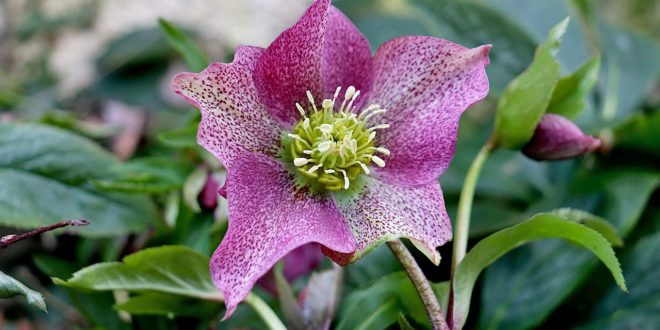Pushing through damp, cold, otherwise lifeless late-autumn soil, the dainty hellebore (commonly known as the ‘winter rose’) is the promise of colour to come. Often appearing in swathes in leaf-mulched beds, it delivers pastel hues of deep plum to pink, and lemon to lichen-green. But although the humble hellebore gladdens the heart of cold-season gardeners, few realise that this pretty plant has a deadly side to it – one which history has taken advantage of.
has taken advantage of.
A member of the buttercup family, the hellebore contains a potentially harmful chemical called ranunculin (if the name rings a bell, that’s because it sounds similar to ‘Ranuncula’, the flowering spring bulb we often plant in our gardens, and which is in the same family as the hellebore). When a hellebore plant is damaged, ranunculin seeps from the wound and is chemically changed into a highly dangerous toxin.
If this toxin comes into contact with skin, it can cause itching, rashes or even blisters. If it is swallowed, symptoms can range from nausea and dizziness to hepatitis, jaundice and even paralysis. But wait – there’s more! Once the toxin is dry and powdery, it can be inhaled – in which case it can bring on sneezing so severe that it has the potential to cause death. To make matters more problematic, all these symptoms can vary in severity according to the species of hellebore a gardener comes into contact with.
The hellebore’s potential to poison has been well documented in a history that ranges from myth to magic, with a hint of truth thrown in. Well known to be a purgative (a substance that causes vomiting and diarrhoea) the roots of hellebore were said to have been used to contaminate the water supply of the ancient Greek city of Krissa as it fought off an attacking enemy. (On the off-chance you plan to besiege a city any time soon, it may pay to note that the ancient Greeks felt that white hellebore were more potent than red!) The Gauls (an Iron and Roman age population who lived in what is now France) also understood the deadly power of the hellebore, and dipped the tips of their arrow heads in a powder made from the dried roots of the plant.
Despite its potential for harm, hellebore extract was also used, historically, to heal (it’s just that the various treatments were more likely to maim or kill than be of any help!). From diabetes to sciatica, hellebore was said to be the answer, and although we now know the opposite is the case, using the plant to treat intestinal worms didn’t cease until the 18th century.
How to help your hellebores
Hellebores grow best in gardens rich in humus (the sort of soil we find in a well-made compost), and enjoy dappled or shaded conditions. Unfortunately, this kind of environment often leaves the plants experiencing conditions that are overly damp and cold, especially in regions with naturally chilly winters. The result is that flowers become damaged in the bud or quickly succumb to damping-off once they have opened.
To help prevent damp-related disease in your hellebores, wait until autumn when you can see the new growth starting to pop through the soil. At this stage, don a pair of long-sleeved gardening gloves and reach for the secateurs. Snip off all the old foliage around the crown of the plants. This will let in the light and encourage the sort of air movement that discourages fungal disease. Sprinkle some animal manure around the plants (keeping it back from the newly developing growth). Along with adequate drainage, this will encourage healthy hellebores with plenty of pretty new blooms.
By Cara Burns









Join the Discussion
Type out your comment here:
You must be logged in to post a comment.